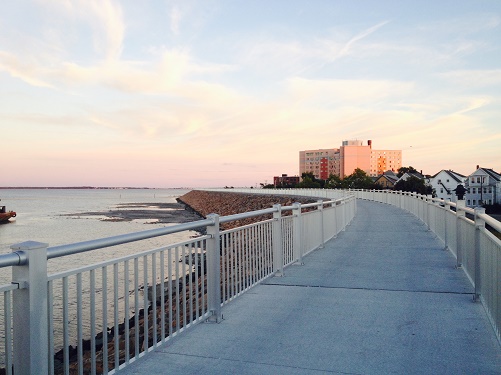New Bedford harbor walk officially opens
Mayor Jon Mitchell, other city officials, community leaders and neighborhood residents came together today to celebrate the official opening of the “Harborwalk”—a new recreational pathway atop New Bedford’s famous Hurricane Barrier that reconnects the public to the city’s waterfront.
Shortly after taking office in 2012, Mayor Mitchell called for the reconnection of New Bedford’s waterfront with residential and downtown areas. A key element of the Mayor’s strategy was the construction of a pathway atop the New Bedford Hurricane Barrier.
“When I got into office, I felt that this was an important project for the City to pursue. We had been cut off from the water for fifty years and there was an opportunity for the public to get up on the barrier and experience spectacular water views. I am very proud that New Bedford didn’t just talk about making this happen, we did it,” said Mayor Mitchell.
“To my knowledge there isn’t another walkway like this anywhere in America, one that is elevated high above the ocean line and extends as far as this one does. It is breathtaking. I don’t think you can walk, run or bike this pathway without reflecting on what a beautiful place this is,” Mayor Jon Mitchell said.
“The Harborwalk opens up the true beauty of the harbor and New Bedford to everyone who wants enjoy it,” Ward Six City Councilor Joe Lopes said of the project.
The Harborwalk connects with a bike path that runs along the waterfront down to the tip of the city’s southern peninsula and into Fort Taber Park. Fort Taber Park is a 50-acre waterfront park that provides over a mile of ocean frontage and overlooks Buzzards Bay. The park incorporates historical landmarks, offers many amenities and various opportunities for passive and active recreation
Construction of the Harborwalk was completed by the City’s Department of Public Infrastructure, contractor P.A. Landers and Seguin Enterprises. The Harborwalk is 3,400 feet long, 14 inches thick and contains 1,500 cubic yards of concrete. Workers installed 6,800 feet of custom-made aluminum railing, and 26,840 feet of electrical wiring to supply power to the 164 light fixtures that illuminate the pathway after sunset.
As a tribute to the importance of the hurricane barrier to the city, workers stamped a hurricane insignia into the concrete pathway and inscribed the names and dates of hurricanes that have tested the barrier.
A second phase of the Harborwalk, which would include extending the recreational pathway atop the Clark’s Cove section of the hurricane barrier, is in the works. The Clark’s Cove phase is the expected to be 3,700 feet long and the City is working to secure funding to complete this portion of the project.
History of the New Bedford Hurricane Barrier
In 1962, construction of the hurricane barrier across New Bedford Harbor began in an effort to greatly minimize the destructive effects of flood waters associated with severe storms. Dedicated in 1966, the hurricane barrier remains the largest manmade structure on the east coast of the United States and provides security for industries, the fishing fleet, and hundreds of homes in residential neighborhoods. The Harbor Barrier and Dike have protected New Bedford and the neighboring communities of Acushnet and Fairhaven from storm surge but, the dike portion of the structure—a massive 18 foot high, 4,600 foot stone wall—has limited public access to the water.
